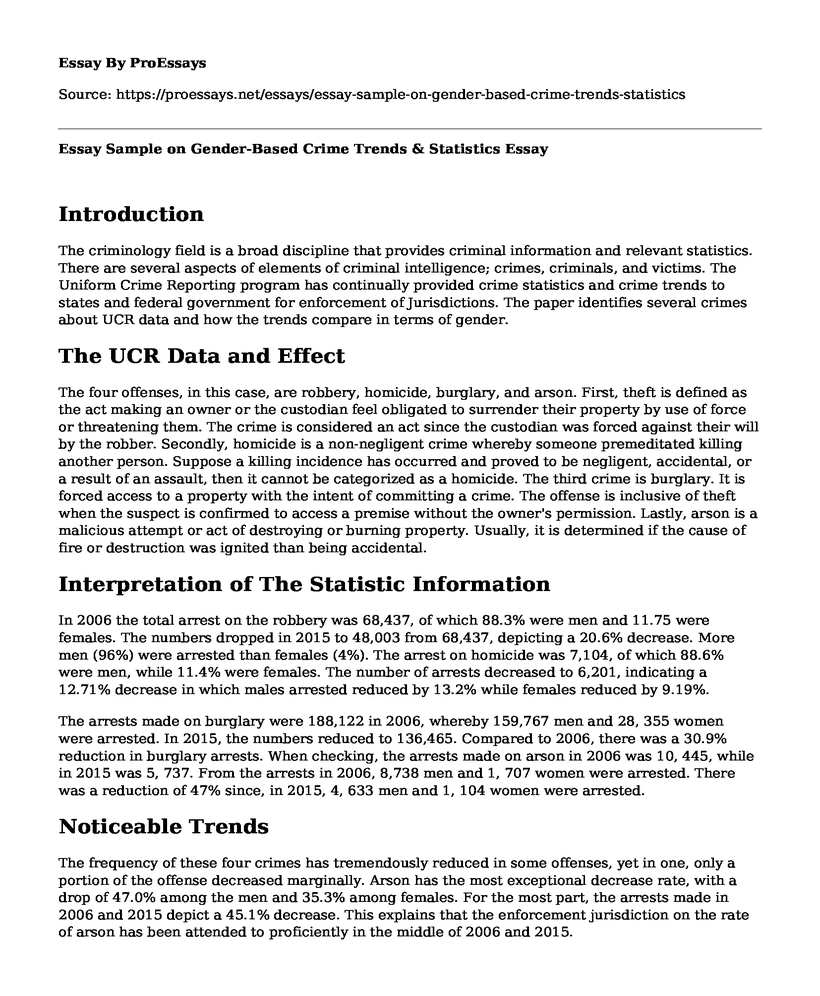Introduction
The criminology field is a broad discipline that provides criminal information and relevant statistics. There are several aspects of elements of criminal intelligence; crimes, criminals, and victims. The Uniform Crime Reporting program has continually provided crime statistics and crime trends to states and federal government for enforcement of Jurisdictions. The paper identifies several crimes about UCR data and how the trends compare in terms of gender.
The UCR Data and Effect
The four offenses, in this case, are robbery, homicide, burglary, and arson. First, theft is defined as the act making an owner or the custodian feel obligated to surrender their property by use of force or threatening them. The crime is considered an act since the custodian was forced against their will by the robber. Secondly, homicide is a non-negligent crime whereby someone premeditated killing another person. Suppose a killing incidence has occurred and proved to be negligent, accidental, or a result of an assault, then it cannot be categorized as a homicide. The third crime is burglary. It is forced access to a property with the intent of committing a crime. The offense is inclusive of theft when the suspect is confirmed to access a premise without the owner's permission. Lastly, arson is a malicious attempt or act of destroying or burning property. Usually, it is determined if the cause of fire or destruction was ignited than being accidental.
Interpretation of The Statistic Information
In 2006 the total arrest on the robbery was 68,437, of which 88.3% were men and 11.75 were females. The numbers dropped in 2015 to 48,003 from 68,437, depicting a 20.6% decrease. More men (96%) were arrested than females (4%). The arrest on homicide was 7,104, of which 88.6% were men, while 11.4% were females. The number of arrests decreased to 6,201, indicating a 12.71% decrease in which males arrested reduced by 13.2% while females reduced by 9.19%.
The arrests made on burglary were 188,122 in 2006, whereby 159,767 men and 28, 355 women were arrested. In 2015, the numbers reduced to 136,465. Compared to 2006, there was a 30.9% reduction in burglary arrests. When checking, the arrests made on arson in 2006 was 10, 445, while in 2015 was 5, 737. From the arrests in 2006, 8,738 men and 1, 707 women were arrested. There was a reduction of 47% since, in 2015, 4, 633 men and 1, 104 women were arrested.
Noticeable Trends
The frequency of these four crimes has tremendously reduced in some offenses, yet in one, only a portion of the offense decreased marginally. Arson has the most exceptional decrease rate, with a drop of 47.0% among the men and 35.3% among females. For the most part, the arrests made in 2006 and 2015 depict a 45.1% decrease. This explains that the enforcement jurisdiction on the rate of arson has been attended to proficiently in the middle of 2006 and 2015.
The other observable pattern is a significant decrease in the number of females committing illegal conflagration violations when contrasted with other crimes. The women captured in 2006 for incendiarism were 1707, and the number decreased to 1104 in 2015. There is a drop of 33.5%. In comparison to the other crimes, there was a 0.4% decrease rate for robbery, 9.19% for homicide, and 8.1% for burglary.
The last recognizable pattern is that men contribute to the highest population captured out of all the four crimes. Between 2006 and 2015, the total number of men arrested was 106,520 compared with 15,920 females in robbery cases. The men captured in the counts of homicide between 2006 and 2015 were 11,755, while 1,550 ladies were arrested. In the robbery, the men arrested in 2006 and 2015. There were 270,183 men arrested while 54,404 women were arrested on counts of burglary. Lastly, there were 13,371 men and 2,811 women detained with arson in between 2006 and 2015.
The Strengths and Limitations of Using UCR as a Crime Data Reporting Tool
The fundamental quality of the UCR framework as a piece of crime information announcing apparatus is it incorporates information from different sources and offices to gather an examination that is anything but difficult to peruse and follow through. This decreases the equivocalness of expectation of information and crime percentage decrease or increment. The significant shortcoming of the UCR framework is the absence of precision in information assortment and introduction. The variety of information depends on reviews and confirmed with further research on similar violations being examined. The nonappearance of a precise information assortment strategy takes out the legitimacy of some substance.
Conclusion
Criminology is dependent on crime reporting to enforce appropriate jurisdiction. The UCR program is a systematic proper that should provide reliable and accurate data. To avoid misconceptions, the UCR ought to provide arrest information and statistics without generalization. Also, the concentration on decreasing arrest-specific crimes to improve public perception should be avoided. These elements are what guides actual crime reporting since every noticeable trend is identified, information and statistic provided, and enforcement jurisdiction is taken.
References
Mallicoat, S. L. (2018). Women, Gender, and Crime: Core Concepts. SAGE Publications.
Kaplan, J. (2018). Uniform Crime Reporting (UCR) Program Data: Arrests by Age, Sex, and Race, 1980-2015.
Cite this page
Essay Sample on Gender-Based Crime Trends & Statistics. (2023, Apr 08). Retrieved from https://proessays.net/essays/essay-sample-on-gender-based-crime-trends-statistics
If you are the original author of this essay and no longer wish to have it published on the ProEssays website, please click below to request its removal:
- Cyrus the Great and the Cyrus Cylinder Essay
- Effect of Architecture in Reducing Crimes - Research Paper
- Essay Sample on 13th: Slavery's Prolonged Legacy of Injustice
- Court Management: Ensuring Equal Justice and Timely Dispute Resolution - Essay Sample
- Essay Example on Criminology Theories and Their Relevance to CBP Careers
- Essay Example on Digital Hacking: Growing Threats in the 21st Century
- Essay Example on Growth Through Civil Rights: Learning About Equality and Justice







